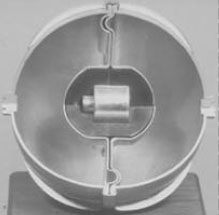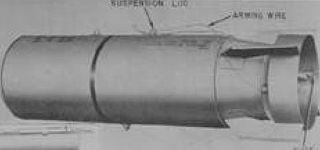
The M33 cluster bomb, also known as the (M33) Brucella cluster bomb, was a U.S. biological cluster bomb developed in the early 1950s and deployed in 1952. It was the first standardized biological weapon in the U.S. arsenal.

The M33 cluster bomb, also known as the (M33) Brucella cluster bomb, was a U.S. biological cluster bomb developed in the early 1950s and deployed in 1952. It was the first standardized biological weapon in the U.S. arsenal.
The U.S. Army Chemical Corps selected Brucella suis as its first mass-produced biological agent in 1949. Tests at Dugway Proving Ground followed in 1950 and 1951. These tests paved the way for the first mass-produced biological weapon in the U.S. arsenal in 1952. [1]
The M33 cluster bomb was a 500-pound (227 kg) biological munition that initially carried the biological agent Brucella suis . The M33 held 108 M114 4-pound (1.8 kg) anti-personnel bombs; each M114 held about 320 milliliters of B. suis culture. [2] Besides B. suis the M33 was tested with other agents throughout the 1950s. [2] The M33 was an air-released munition: released at high altitude, it would eject its bomblets while still aloft. Each bomblet would then explode using its own detonator. [3]
The M33 presented a special logistical problem. The agent used, B. suis, required refrigeration which created a logistical "nightmare". [1] In addition, experts calculated that to attain a proper infection rate over an area of one square mile up to 16 separate M33s were required; [1] around 1,500 individual bomblets. [3] The large number of biological weapons made transport of the weapons for 1952 tests more difficult. [3] The M33 cluster bomb was never used in battle. [1]
The M33 cluster bomb was used in a series of tests from August-October 1952. At Dugway Proving Ground, Utah, the Army Chemical Corps exposed over 11,000 guinea pigs to B. suis via air-dropped M33s. [3] Although the guinea pig trials caused one Chemical Corps general to remark, "Now we know what to do if we ever go to war against guinea pigs", [3] the tests resulted in the realization that the M33 could not compete with the casualty volume caused by atomic weapons.
The United States biological weapons program officially began in spring 1943 on orders from U.S. President Franklin D. Roosevelt. Research continued following World War II as the U.S. built up a large stockpile of biological agents and weapons. Over the course of its 27-year history, the program weaponized and stockpiled seven bio-agents — Bacillus anthracis (anthrax), Francisella tularensis (tularemia), Brucella spp (brucellosis), Coxiella burnetii (Q-fever), Venezuelan equine encephalitis virus, Botulinum toxin (botulism), and Staphylococcal enterotoxin B. The US also pursued basic research on many more bio-agents. Throughout its history, the U.S. bioweapons program was secret. It was later revealed that laboratory and field testing had been common. The official policy of the United States was first to deter the use of bio-weapons against U.S. forces and secondarily to retaliate if deterrence failed.

The M139 bomblet was an American sub-munition designed for use in warheads as a chemical cluster munition. Each spherical bomblet held 1.3 pounds (590 g) of sarin nerve agent.
The M143 bomblet was a biological cluster bomb sub-munition developed by the United States during the 1960s. The spherical bomblet was the biological version of the Sarin-filled M139 chemical bomblet.

The M114 bomb was a four-pound U.S. anti-personnel bomb and biological cluster bomb sub-munition. The M114 was used in the M33 cluster bomb.

The Flettner rotor bomblet was a U.S. biological sub-munition that was never mass-produced. Based on the vertical Flettner rotor which takes advantage of the Magnus effect, a force acting on a spinning body in a moving airstream, it was developed toward the end of the U.S. biological weapons program in the 1960s.

The M34 cluster bomb was the first mass-produced United States Army weapon meant to deliver the chemical agent sarin (GB). A large stockpile of M34s was destroyed between 1973 and 1976.

The M43 BZ cluster bomb, or simply M43 cluster bomb, was a U.S. chemical cluster bomb intended to deliver the incapacitating agent known as BZ. The weapon was produced in the early 1960s and all stocks of U.S. BZ were destroyed by 1989.
The M138 bomblet was a sub-munition of the U.S. chemical weapon, the M43 BZ cluster bomb. The bomblet contained BZ, an incapacitating agent and was developed with the M43 in 1962. The M138s, along with all other U.S. BZ weapons were destroyed during the 1980s.

Operation Big Itch was a U.S. entomological warfare field test using uninfected fleas to determine their coverage and survivability as a vector for biological agents. The tests were conducted at Dugway Proving Ground in 1954.
The E14 munition was a cardboard sub-munition developed by the United States biological weapons program as an anti-crop weapon. In a series of field tests in 1955, the E14 was loaded with fleas and air-dropped.
The E86 cluster bomb was an American biological cluster bomb first developed in 1951. Though the U.S. military intended to procure 6,000 E86s, the program was halted in the first half of the 1950s.
The E61 anthrax bomblet was an American biological sub-munition for the E133 cluster bomb. This anti-personnel weapon was developed in the early 1950s and carried 35 milliliters of anthrax spores or another pathogen.
The M125 bomblet was a U.S. chemical sub-munition designed to deliver the nerve agent sarin. It was brought into service in 1954 with the M34 cluster bomb as part of the first U.S. air-delivered nerve agent weapon.

The MC-1 bomb was the first U.S. non-clustered air-dropped chemical munition. The 750-pound (340 kg) MC-1 was first produced in 1959 and carried the nerve agent sarin.
The E48 particulate bomb was a U.S. biological sub-munition designed during the 1950s for use with the E96 cluster bomb.

The M134 bomblet was a U.S. chemical cluster munition designed for use in the MGR-1 Honest John rocket during the 1950s. The weapon was never mass-produced and was supplanted in 1964 by an improved design, the M139.
The Granite Peak Installation (GPI) — also known as Granite Peak Range — was a U.S. biological weapons testing facility located on 250 square miles (650 km2) of Dugway Proving Ground in Utah. The GPI was a sub-installation of Dugway but had its own facilities, including utilities. Established in 1943, GPI was deactivated with the end of World War II.
Before the 20th century, the use of biological agents took three major forms: